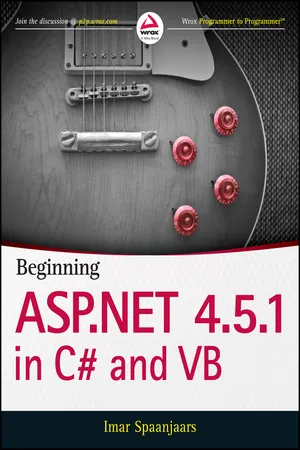
- English
- ePUB (mobile friendly)
- Available on iOS & Android
Beginning ASP.NET 4.5.1: in C# and VB
About this book
Build your ASP.NET 4.5.1 skills with real-world instruction In this comprehensive guide to getting started with ASP.NET 4.5.1, best-selling author Imar Spaanjaars provides a firm foundation for coders new to ASP.NET and key insights for those not yet familiar with the important updates in the 4.5.1 release. Readers learn how to build full-featured ASP.NET websites using Visual Studio Express 2013 for Web, Microsoft's free development tool for ASP.NET web applications. Beginning ASP.NET 4.5.1 guides you through the process of creating a fully functional, database-driven website, from creation of the most basic site structure all the way down to the successful deployment of the website to a production environment.
Beginning ASP.NET 4.5.1: in C# and VB:
- Explains how to get started with ASP.NET 4.5.1, including an introduction to Microsoft's Visual Studio Express 2013 for Web
- Features helpful examples for designing websites with CSS and HTML and how to overcome common formatting problems
- Shares techniques for managing server controls in ASP.NET, including standard controls, HTML controls, and data controls
- Provides real-world tips for creating consistent page layouts throughout your websites
- Covers practical functionality issues like validating user input, sending e-mail from your website, and processing data at the server
- Details what the ASP.NET state engine is and why it is important
- Shows how to access and modify data in a SQL Server database
- Includes coverage of jQuery, LINQ, and the Entity Framework
- Explores measures to take for optimal security
Frequently asked questions
- Essential is ideal for learners and professionals who enjoy exploring a wide range of subjects. Access the Essential Library with 800,000+ trusted titles and best-sellers across business, personal growth, and the humanities. Includes unlimited reading time and Standard Read Aloud voice.
- Complete: Perfect for advanced learners and researchers needing full, unrestricted access. Unlock 1.4M+ books across hundreds of subjects, including academic and specialized titles. The Complete Plan also includes advanced features like Premium Read Aloud and Research Assistant.
Please note we cannot support devices running on iOS 13 and Android 7 or earlier. Learn more about using the app.
Information
Chapter 1
Getting Started with ASP.NET 4.5.1
- How to acquire and install Visual Studio Express 2013 for Web and Visual Studio 2013
- How to create your first website with Visual Studio Express 2013
- How an ASP.NET page is processed by the server and sent to the browser
- How you can use and customize the development environment
- A clean separation between presentation and code. With classic ASP, your programming logic was often scattered throughout the HTML of the page, making it hard to make changes to the page later.
- A development model that was much closer to the way desktop applications are programmed. This made it easier for the many Visual Basic desktop programmers to make the switch to web applications.
- A feature-rich development tool (called Visual Studio .NET) that enabled developers to create and code their web applications visually.
- A choice between a number of object-oriented programming (OOP) languages, of which Visual Basic .NET and C# (pronounced as C-Sharp) are now the most popular.
- Access to the entire .NET Framework, which for the first time meant that web developers had a unified and easy way to access many advanced features to work with databases, files, e-mail, networking tools, and much more.
MICROSOFT VISUAL STUDIO EXPRESS FOR WEB
Getting Visual Studio
Table of contents
- Cover
- Contents
- Chapter 1: Getting Started with ASP.NET 4.5.1
- Chapter 2: Building an ASP.NET Website
- Chapter 3: Designing Your Web Pages
- Chapter 4: Working with ASP.NET Server Controls
- Chapter 5: Programming Your ASP.NET Web Pages
- Chapter 6: Creating Consistent Looking Websites
- Chapter 7: Navigation
- Chapter 8: User Controls
- Chapter 9: Validating User Input
- Chapter 10: ASP.NET AJAX
- Chapter 11: jQuery
- Chapter 12: Introducing Databases
- Chapter 13: Displaying and Updating Data
- Chapter 14: LINQ and the ADO.NET Entity Framework
- Chapter 15: Working with Data — Advanced Topics
- Chapter 16: Security in Your ASP.NET Website
- Chapter 17: Personalizing Websites
- Chapter 18: Exception Handling, Debugging, and Tracing
- Chapter 19: Deploying Your Website
- Appendix A: Exercise Answers
- Appendix B: Configuring SQL Server 2012
- Introduction
- Advertisement
- End User License Agreement